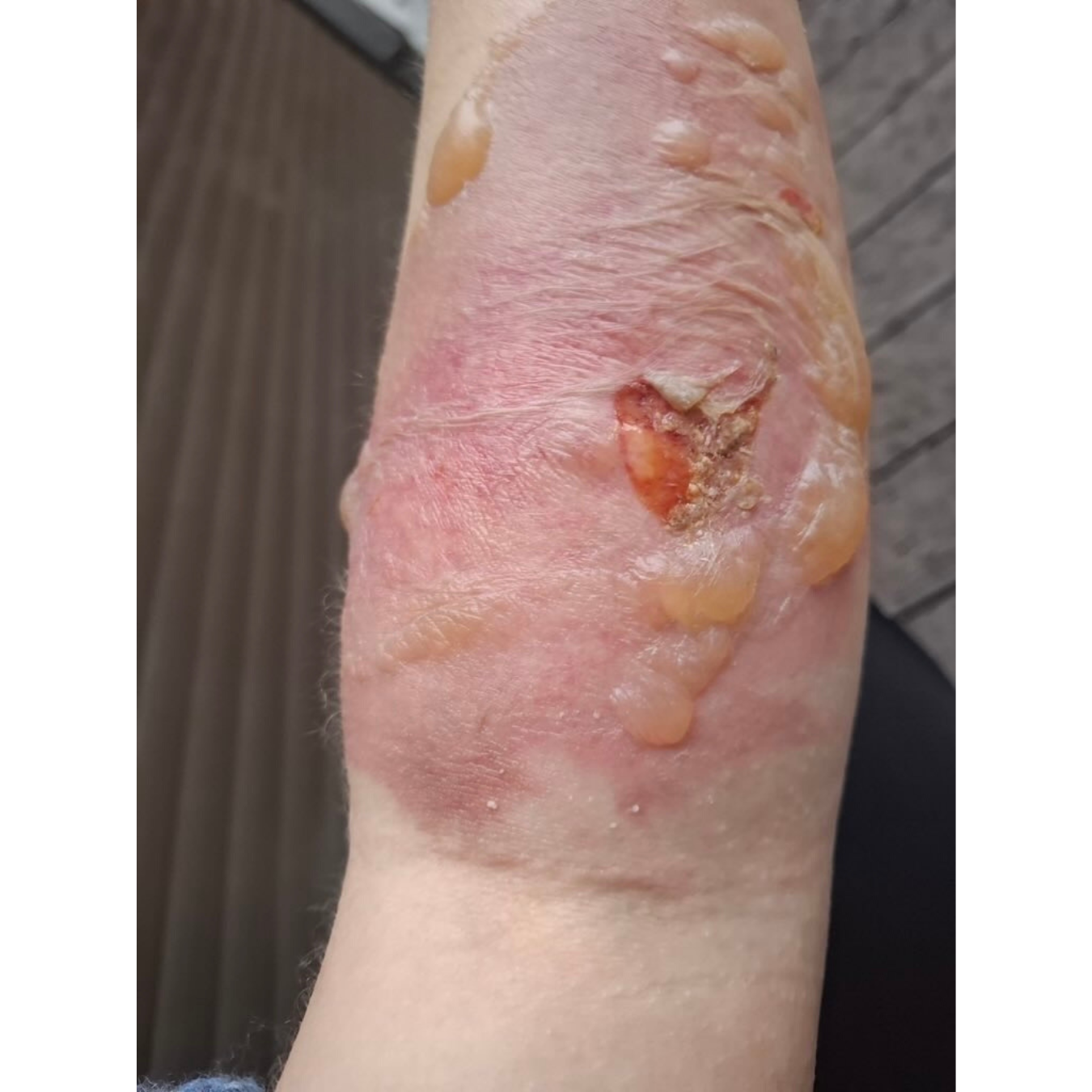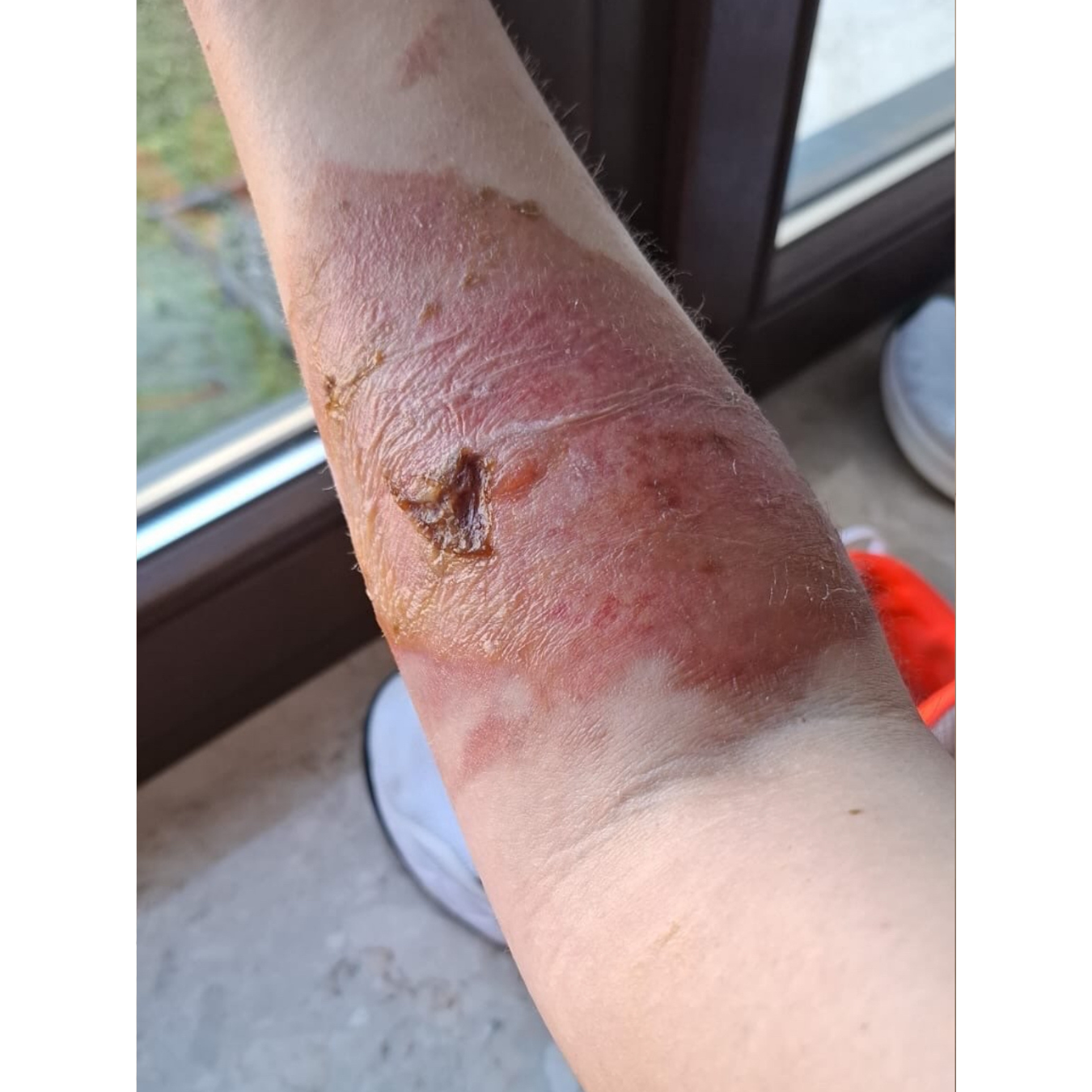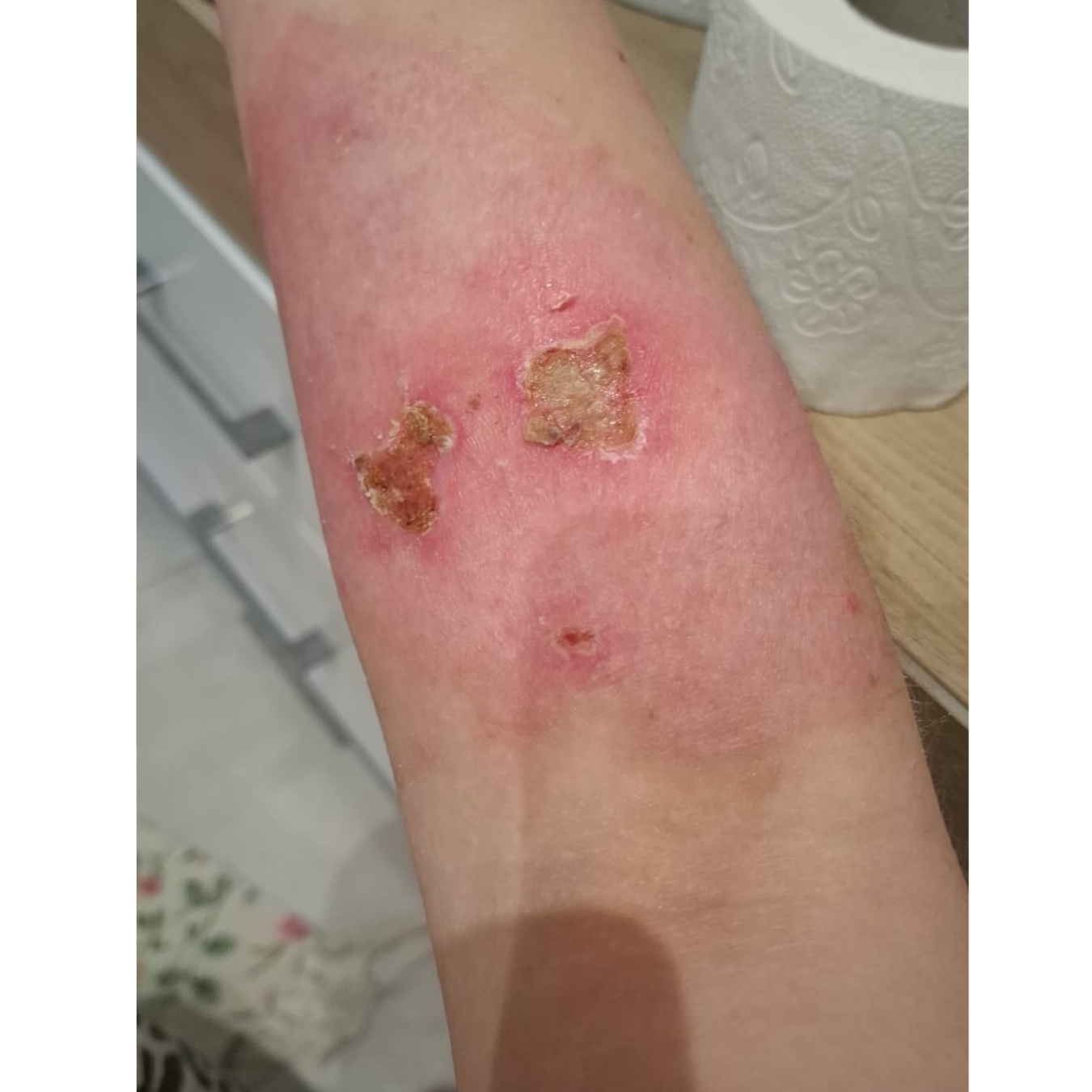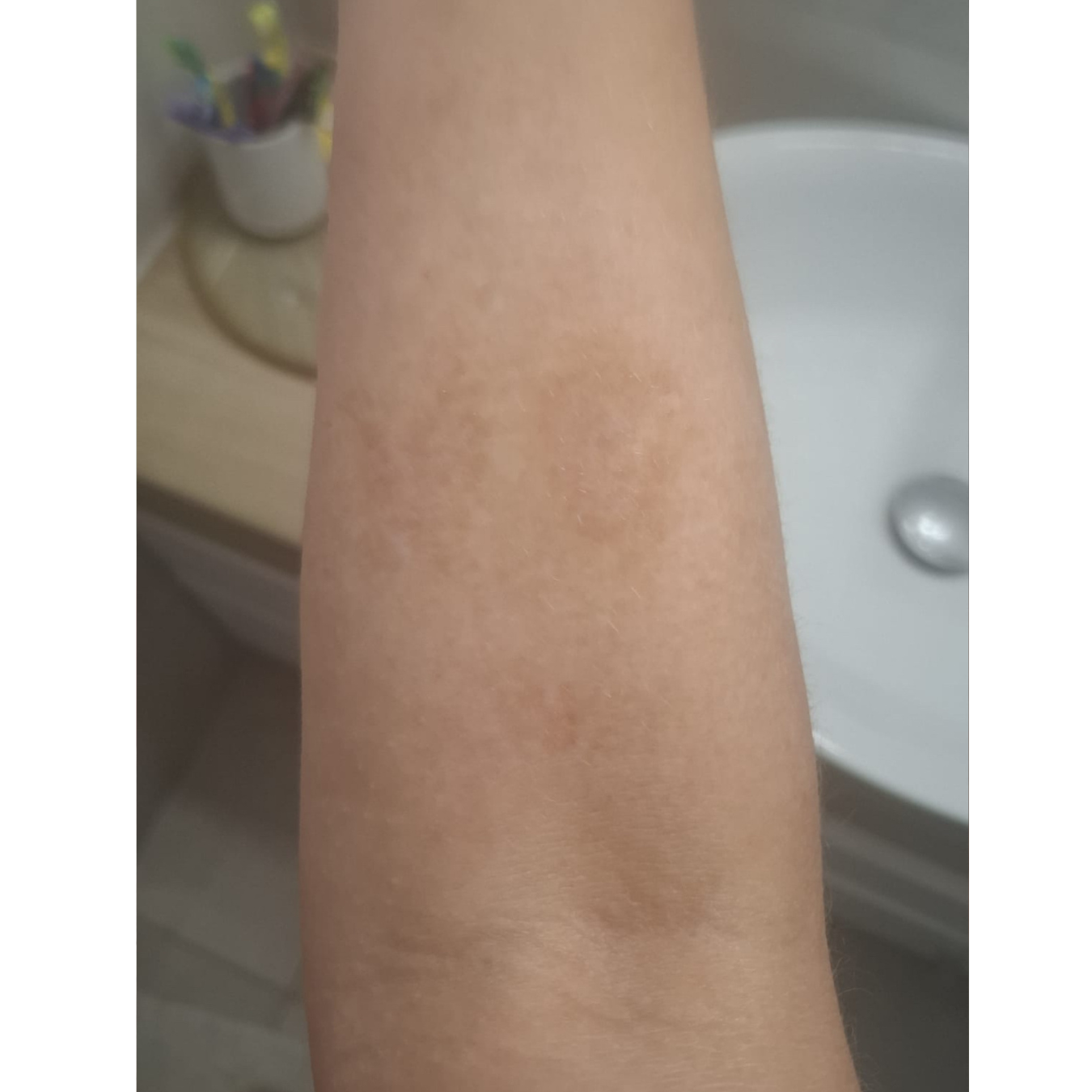Dr. Mark Iwanicki, ND, LAc
In collaboration with Anna Żukowska, RN
Introduction
Black seed (Nigella sativa) oil has been used for centuries across the Mediterranean, Middle East, and Europe for its wide-ranging therapeutic benefits. Known in Polish as olej z czarnuszki, it has a long tradition in folk medicine as a topical and internal remedy for inflammation, infection, and skin regeneration.
Modern pharmacological research confirms these traditional uses. The oil’s primary bioactive constituent, thymoquinone, exhibits potent antioxidant, anti-inflammatory, antimicrobial, and wound-healing effects through modulation of oxidative stress, growth factors, and collagen synthesis (1–5). These properties make Nigella sativa an appealing natural adjunct in the management of burns and skin injuries.
The following case describes the complete recovery of a 28-year-old woman from a deep partial-thickness scald burn to the forearm. The injury occurred in March 2025 and was treated exclusively at home by her mother-in-law, Anna Zukowska, a nurse with wound-care experience using black seed oil. Healing was complete within one month, with normal skin appearance restored by three months.
Case Description
Patient: Female, 28 years old, healthy, no diabetes or chronic disease.
Date of injury: March 9, 2025.
Cause: Accidental spill of boiling water.
Location: Volar surface of right forearm.
Within hours of the incident, multiple tense blisters developed over a red, swollen base-consistent with a deep partial-thickness (second-degree) thermal burn covering an estimated 6 × 8 cm area. The burn was extremely painful and showed no signs of infection at presentation.
(Day 1 – Initial presentation with multiple blisters and erythema.)
Treatment Procedure
The wound was managed entirely at home under the supervision of Anna Zukowska, RN (ret.) using a simple, sterile technique.
Cleansing and disinfection: The wound was cleaned daily with Octenisept antiseptic spray. Alternatives such as Rivanol or colloidal silver could also be used. Hydrogen peroxide was avoided to prevent tissue irritation.
Blister drainage: Intact blisters were carefully punctured using a sterile needle to relieve pressure and allow fluid drainage.
Application of black seed oil: Sterile gauze pads were soaked in cold-pressed Nigella sativa oil (EkaMedica, Poland). Each pad was used once only and never re-dipped into the oil container to maintain aseptic conditions. The gauze was gently pressed onto the wound until the surface was lightly moistened.
Cold-air drying: Immediately afterward, Anna used a hair dryer on the cool-air setting from a safe distance to gently dry the surface. This step promoted rapid scab formation and reduced infection risk.
Frequency: The full procedure was performed once daily in the evening after the patient returned from work.
The wound was kept uncovered whenever possible to allow airflow. No topical antibiotics, steroid creams, or occlusive dressings were applied.
Day 7 – Scab formation with clean wound margins and no exudate.
Outcome
Pain remained intense for the first three to four days but decreased quickly after blister drainage and the initiation of Nigella sativa oil with cold-air drying. The patient reported a soothing effect from both the oil and the cool air.
Scab formation occurred rapidly by the fifth day, and epithelialization was visible by day twelve. The wound achieved full closure within approximately thirty days. No signs of infection or pus were observed during the entire healing period. Only mild pigmentation remained at the sites where blisters had ruptured spontaneously, with no evidence of scarring or contracture.
After the scabs detached, Paula began massaging black seed oil directly into the healed skin with her fingertips once daily. The oil quickly absorbed, restoring moisture and elasticity. Occasional dryness after washing resolved immediately with oil application.
Day 18 – Epithelialization with minimal erythema.
Day 30 – Complete healing with slight pigmentation only.
At three-month follow-up, the skin tone was nearly identical to the surrounding area. Only faint pigment traces were visible where blisters had once ruptured. The skin was smooth, flexible, and showed no signs of fibrosis, hypertrophic scarring, or textural irregularity.
3-Month follow-up – Fully matured skin, pigmentation nearly resolved, no visible scarring.)
Discussion
In deep partial-thickness burns, the normal healing process typically takes 30 to 40 days and often results in moderate scarring, residual hyperpigmentation, and risk of infection if not properly managed (7). In this case, healing was observed at the faster end of that range and with superior cosmetic and functional outcomes.
Scabs formed by the fifth day-considerably earlier than expected-and complete epithelial closure was achieved within a month. Pain resolved within three to five days, rather than the usual one to two weeks reported in conventional burn healing. These findings suggest that the combined use of Nigella sativa oil and cold-air drying not only accelerated recovery but also improved the quality of healing, with minimal discomfort and no need for antibiotics or occlusive dressings.
The absence of infection throughout the course is notable, given the open nature of the wound and the lack of conventional wound coverings. This supports the antimicrobial and anti-inflammatory properties of Nigella sativa oil as documented in experimental studies (1–4).
Mechanisms of Action
The therapeutic effects of Nigella sativa arise primarily from its bioactive constituents—thymoquinone, carvacrol, nigellidine, and essential fatty acids (linoleic, oleic, palmitic).
Documented mechanisms include:
Anti-inflammatory activity: Thymoquinone inhibits cyclooxygenase and lipoxygenase pathways, reducing pro-inflammatory mediators (1).
Antioxidant defense: Enhances cellular antioxidant enzymes such as superoxide dismutase and glutathione peroxidase, protecting regenerating tissue from oxidative stress (2)
Antimicrobial effect: Effective against Staphylococcus aureus, Candida, and other pathogens, lowering infection risk (3)
Tissue regeneration: Stimulates fibroblast proliferation, angiogenesis, and collagen synthesis, promoting faster epithelialization (4)
Analgesic effect: Modulates nociceptive pathways and reduces oxidative stress, contributing to early pain relief (5)
The cold-air drying technique likely amplified these benefits by creating a semi-dry, oxygen-rich wound environment that discouraged bacterial colonization and encouraged rapid crust formation and healing.
Broader Clinical Context
Anna Zukowska has applied this same technique in numerous wound-care cases with consistent success. One of the most remarkable involved her mother-in-law, who sustained an extensive fourth-degree burn to the foot, with tissue damage extending to the bone and covering nearly the entire surface. The foot was initially considered for amputation. Through nearly two years of dedicated daily care-involving meticulous wound cleansing, application of Nigella sativa oil, and controlled cold-air drying-Anna achieved full wound closure and tissue regeneration. The outcome preserved both the structure and function of the foot. She later discussed her methods with physicians and dermatologists, many of whom expressed deep interest in her results. Her work exemplifies how traditional nursing diligence combined with natural pharmacology can achieve extraordinary outcomes, even in cases deemed beyond repair.
Conclusion
This case documents the rapid, complication-free healing of a deep partial-thickness scald burn treated exclusively with topical Nigella sativa oil, daily antiseptic cleansing, and cold-air drying. The patient achieved full epithelialization within one month and complete skin normalization by three months, without infection or scarring.
Given its anti-inflammatory, antimicrobial, and regenerative properties, black seed oil may serve as a valuable complementary therapy in the management of superficial and partial-thickness burns. Controlled clinical studies are warranted to evaluate standardized protocols and determine its integration into modern burn care.
References
Ameer OZ, Salman IM, Al-Masri IM, et al. Nigella sativa and its active compound thymoquinone: a review on the therapeutic effects on skin and wound healing. Front Pharmacol. 2020;11:994.
Hameed IH, Mohammed GJ, Kareem MA. Burn healing potential of Nigella sativa seed oil in rats. Int J Pharm Sci Rev Res. 2016;39(1):142–147.
Gholamnezhad Z, Havakhah S, Boskabady MH. Preclinical and clinical effects of Nigella sativa and its constituent thymoquinone: a review. J Ethnopharmacol. 2016;190:372–386.
Salem AM, Botros RM, Attia ZR, et al. Nigella sativa L. seed extracts promote wound healing progress by activating VEGF and PDGF signaling pathways. F1000Research. 2023;12:436.
Alshammari GM, Al-Kahtani MA, Ahmed MM, et al. How thymoquinone from Nigella sativa accelerates wound healing: a review of molecular and cellular mechanisms. Front Pharmacol. 2023;14:1087012.
Faz AA, Hegazy R, Ezzeldin N, et al. Effects of Nigella sativa and silver sulfadiazine on burn wound healing in rats. Vet Med-Czech. 2010;55(12):619–628.
American Burn Association. Practice Guidelines for Burn Care. 2020 update. Chicago, IL: American Burn Association; 2020.
Author Note
Case reported by Dr. Mark Iwanicki, ND, LAc, in collaboration with Anna Zukowska, RN (ret.).






